
Elymus glaucus is a species of grass known as blue wild rye or blue wildrye. This grass is native to North America from Alaska to New York to northern Mexico. It is a common and widespread species of wild rye.
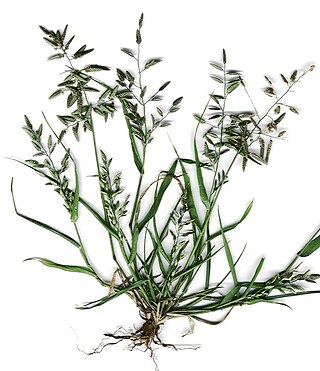
Eragrostis cilianensis is a species of grass known by several common names, including stinkgrass, candy grass, and gray lovegrass.

Eragrostis hypnoides is a species of grass known by the common name teal lovegrass. It is native to the Americas from Canada to Argentina. It is found in moist areas near water in substrates of sand or mud.

Achnatherum lettermanii is a species of grass known by the common name Letterman's needlegrass. The updated and accepted name is Stipa lettermanii. It is native to the western United States from California to Montana to New Mexico, where it is a resident of several types of habitat.

Stipa parishii, formerly classified as Achnatherum parishii, is a species of grass known by the common name Parish's needlegrass. The Jepson Manual 2nd edition (2012) reclassified the plant as Stipa parishii var. parishii.

Aristida divaricata is a species of grass known by the common name poverty threeawn. It is native to the Americas from the central United States to Guatemala. It is a perennial grass forming clumps of unbranched stems up to 70 centimeters tall. Leaves are mostly basal and roll along the edges. The sparse inflorescence is a wide, flat, open array of spikelets that break apart easily. The grain has a twisted tip and three awns up to 2 centimeters long.
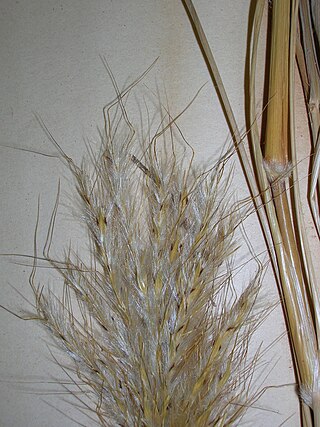
Bothriochloa barbinodis is a species of grass known by the common name cane bluestem. It is native to the Americas, including most of South and Central America, Mexico, and the southernmost continental United States from California to Florida.

Briza minor is a species of grass known by the common names lesser quaking-grass or little quakinggrass. It is native to the Mediterranean Basin, and it is known elsewhere, including much of North America, as an introduced species. It is an annual grass producing narrow clumps of erect stems up to 50 centimeters tall. The inflorescence bears several small cone-shaped spikelets, each hanging on a pedicel.

Bromus vulgaris is a species of brome grass known by the common name Columbia brome.

Cynosurus echinatus is a species of grass known by the common names bristly dogstail grass, rough dog's-tail and hedgehog dogtail. It is native to southern Europe, and it is known in the Americas and Australia as an introduced species and sometimes a noxious weed. An herbicide-resistant strain can be found growing as a weed in canola and wheat fields in Chile. This is an annual grass growing 10 to 50 centimeters tall. The inflorescence is a rounded or oval cluster or series of clusters of spikelets. The fertile spikelet has an awn up to a centimeter long. The awns clumped closely together into a tuft gives the inflorescence its bristly, hairy appearance.

Melica aristata is a species of grass known by the common names awned melic and bearded melicgrass.

Muhlenbergia appressa, the Devils Canyon muhly, is a species of grass. It is native to the desert region where California and Arizona border Baja California. Muhlenbergia appressa has also been collected on San Clemente Island, one of the Channel Islands of California, in the chaparral and woodlands habitat..
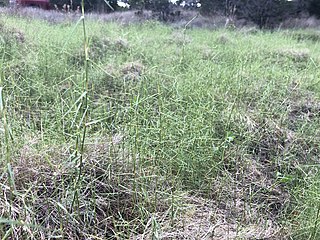
Muhlenbergia utilis is a species of grass known by the common name aparejograss.
Panicum urvilleanum is a species of grass known by the common names desert panicgrass and silky panicgrass. It is native to the southwestern United States and northern Mexico, where it grows in sandy habitat, including the dunes of the deserts. It is also known in parts of South America.
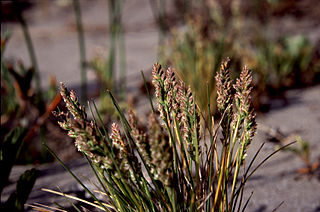
Poa confinis is a species of grass known by the common names coastline bluegrass and beach bluegrass. It is native to the coastline of western North America from British Columbia to northern California, where it grows on beaches, dunes, and other coastal habitat.
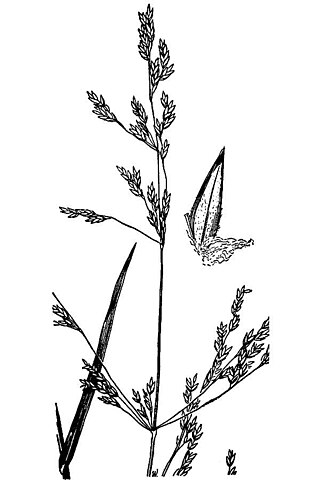
Poa howellii is a species of grass known by the common name Howell's bluegrass.

Poa leptocoma is a species of grass known by the common names marsh bluegrass and western bog bluegrass.

Ventenata dubia is a species of grass known by the common names North Africa grass and wiregrass. It is native to southern Europe, North Africa and the Middle East. It is becoming well known in North America, where it is an introduced species and a noxious weed of cultivated and disturbed habitat. It is problematic in the Pacific Northwest, where it was first identified in Washington in 1952 and Idaho in 1957. It was found in Utah in 1996. It probably spreads when it gets mixed in with grass seed and is transported and inadvertently planted.
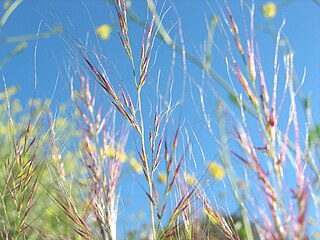
Vulpia microstachys is a species of grass known by the common names small fescue and small sixweeks grass. It is native to western North America from British Columbia to Colorado and New Mexico to Baja California, where it grows in many types of open habitat, including grasslands. It is dominant on some grasslands of California, and it was probably an abundant native grass before the habitat was altered by invasive non-native grasses. It occurs on serpentine soils with associates such as serpentine reedgrass. It is also known from parts of South America. It is an annual grass producing one stem or a clump of several stems growing up to 75 centimeters tall. The inflorescence has several open branches bearing clusters of purple-tinged spikelets. The spikelet has one to six flowers. The grass is usually cleistogamous, its flowers fertilizing themselves.

Aristida purpurascens is a species of grass known by the common name arrowfeather threeawn. It is native to eastern North America. One of the three varieties has a distribution extending south into Honduras.
This page is based on this
Wikipedia article Text is available under the
CC BY-SA 4.0 license; additional terms may apply.
Images, videos and audio are available under their respective licenses.



















